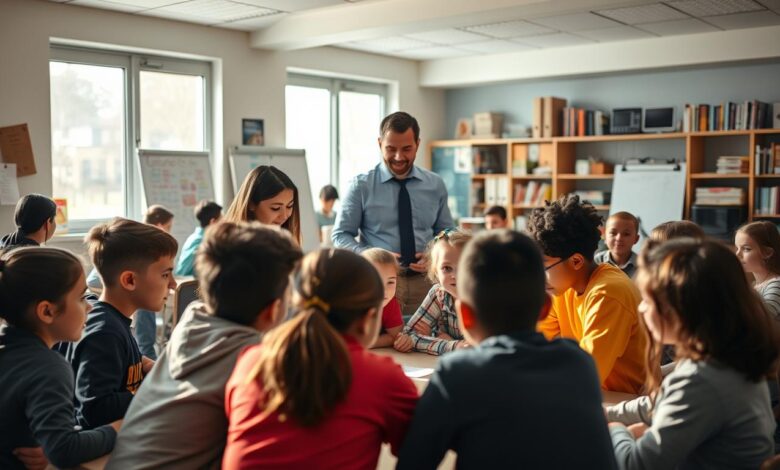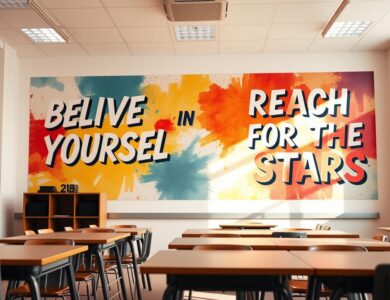
Getting students involved in learning is key to their success. When students are motivated, they do better in class. They learn more and get better grades.
The role of students motivation is huge. It drives student engagement, making learning more effective.
Teachers can use proven methods to create a motivated and engaged classroom. This leads to better grades and success for students.The Science Behind Students Motivation
The link between motivation, neuroscience, and teaching is key. Knowing how motivation works in the brain helps teachers. This knowledge boosts improving student motivation and grades.
Understanding Intrinsic vs. Extrinsic Motivation
Motivation comes in two forms: intrinsic and extrinsic. Intrinsic motivation comes from within, driven by personal interest. Extrinsic motivation comes from outside, like rewards or praise.
Key Differences and Their Impact on Learning
Intrinsic motivation leads to deeper learning and more effort. But, too much extrinsic motivation can harm it. This is why balance is important.
The Neuroscience of Motivation in Learning
Neuroscience has made big strides in understanding motivation. Dopamine, a brain chemical, is key in motivating us. Knowing this helps create student success strategies that work with the brain.
Motivation Theories That Inform Educational Practice
Many theories guide teaching. Self-Determination Theory is one. It says autonomy, competence, and relatedness are key for motivation.
Self-Determination Theory in the Classroom
Using Self-Determination Theory in class means creating a supportive environment. It’s about giving students freedom, building their skills, and fostering positive relationships. This boosts intrinsic motivation and student engagement.
Creating a Positive Learning Environment
To boost student motivation, we need a supportive and engaging learning space. A well-designed classroom can greatly improve student engagement and motivation.
Designing Physical Spaces That Inspire
The classroom’s layout is key to student motivation. Flexible seating and collaborative workspaces help build a sense of community and encourage students to participate.
Classroom Arrangements That Promote Engagement
Effective classroom setups include:
- Flexible seating for different learning styles
- Spaces for group work
- A tidy layout to reduce distractions

Establishing Psychological Safety for Risk-Taking
Creating a safe space is crucial for students to take risks and fully engage in learning. As
“The most important thing in creating a safe learning environment is to establish a sense of community and respect among students.”
This means fostering a culture of respect, empathy, and understanding.
Building a Community of Learners
Creating a community of learners is more than just group work. It’s about setting collaborative norms and practices that foster respect and teamwork.
Collaborative Norms and Practices
Effective collaborative norms include:
- Active listening and respectful dialogue
- Shared responsibility for tasks
- Constructive feedback for growth
By using these strategies, teachers can build a positive learning environment. This environment boosts student motivation and leads to better academic results.
Setting Clear Goals and Expectations
Setting clear goals is key to boosting student motivation. When students know what’s expected, they can focus better. This helps them work more effectively towards their goals.
Implementing the SMART Goal Framework
The SMART goal framework is a great way to motivate students. SMART means Specific, Measurable, Achievable, Relevant, and Time-bound. It helps students set clear, doable goals.
Step-by-Step Goal Setting with Students
- Identify the goal: Find out what the student wants to achieve.
- Make it SMART: Make sure the goal is specific, measurable, achievable, relevant, and time-bound.
- Create an action plan: Outline the steps to reach the goal.
- Track progress: Check and adjust the goal regularly.
Making Learning Objectives Transparent
Being clear about learning objectives is key for success. When students know what they’re learning, they can dive in deeper.
Clear communication of what’s expected keeps students on track and motivated.
Teaching Students to Self-Monitor Progress
Teaching students to track their own progress is vital. It helps them become independent learners. By monitoring their progress, students can see where they need to improve and adjust their plans.
Tools and Techniques for Goal Tracking
There are many tools and techniques for tracking goals, such as:
- Progress charts
- Goal-setting journals
- Digital apps for tracking progress

Proven Techniques to Enhance Students Motivation
Boosting student motivation is key to a productive classroom. Teachers can use certain strategies to make learning more engaging and motivating.
The Power of Choice and Autonomy
Letting students choose what they learn makes them feel more in charge. Autonomy support is a big motivator. It lets students pick topics that interest them.
Structured Choice Activities
Structured choice activities give students autonomy. For instance, they can pick project topics or assignments. This boosts their interest and engagement.
| Activity Type | Description | Benefits |
|---|---|---|
| Project-based choices | Students choose topics for in-depth projects | Increased autonomy, deeper learning |
| Assignment options | Students select from a range of assignments | Enhanced engagement, personalized learning |
Relevance: Connecting Content to Student Lives
Linking what students learn to their lives keeps them interested. When they see the value, they stay motivated.
“When learners can connect what they’re learning to their own lives or to the world around them, they’re more likely to be engaged and motivated.”
Challenge: Finding the Optimal Difficulty Level
Finding the perfect challenge is vital. Tasks that are too simple can bore students. Tasks that are too hard can frustrate them.
Implementing Scaffolded Challenges
Scaffolding challenges offer temporary help with tough tasks. It helps students grow in confidence and skills.

By using these methods, teachers can make learning more engaging and motivating for their students.
Leveraging Technology for Engaged Learning
Using technology is key for keeping students engaged, especially in online classes. By adding digital tools and new tech, teachers can really boost student motivation in online learning.
Digital Tools That Increase Participation
Digital tools are essential for getting students involved in online classes. Interactive platforms let students work together and share ideas right away.
Gamification Elements That Motivate
Gamification helps too. Adding game-like features like points and leaderboards makes learning fun and exciting.
Virtual and Augmented Reality in Education
VR/AR technologies give students a hands-on learning experience. They make learning fun and help students understand tough topics better.
Case Studies of Successful Implementation
Many schools have used VR/AR and seen great results. For example, a study on VR in science showed students got more interested and motivated.
Feedback Systems That Drive Student Growth
Feedback systems are key for student growth and motivation. Timely, specific, and actionable feedback boosts learning and helps students reach their goals.
The Art of Constructive Feedback
Constructive feedback is essential for learning. It points out areas for improvement and praises students’ efforts.
Timing, Specificity, and Actionability
Feedback must be given at the right time. It should be specific and clear about how to get better.
- Timely Feedback: Given soon after a task is done.
- Specific Feedback: Focuses on certain parts of the work.
- Actionable Feedback: Gives clear ways to improve.
Peer Feedback Structures and Protocols
Peer feedback helps students grow. Through peer review, they learn to give and receive constructive feedback.

Recognition Systems That Reinforce Effort
Recognition systems are vital for motivation. They reward students’ hard work and progress, creating a positive learning space.
Beyond Grades: Alternative Assessment Approaches
Alternative assessments, like competency-based progression and self-assessment, offer a broader view of student success.
- Competency-based progression checks students’ skills and knowledge.
- Self-assessment helps students reflect on their learning and set goals.
Building Relationships That Foster Student Motivation
Creating strong bonds between teachers and students is key to keeping students motivated. When students feel understood and valued, they tend to stay engaged and motivated.
Teacher Presence and Its Impact on Engagement
Teacher presence is vital for keeping students interested. Simple actions like greeting students warmly, using positive body language, and showing real interest in their lives can boost their motivation a lot.
Daily Practices for Connection Building
- Personalized greetings
- One-on-one check-ins
- Using students’ names and interests in lesson examples
Cultural Responsiveness in Student Interactions
Being culturally responsive is crucial for building trust with students from different backgrounds. Teachers who respect and understand their students’ cultural backgrounds can make learning more inclusive and motivating.
“When teachers understand and value the cultural backgrounds of their students, they can tailor their teaching practices to better meet the needs of their diverse learners.”
Mentoring Approaches for Different Age Groups
| Age Group | Mentoring Approach |
|---|---|
| Elementary | Focus on building trust and basic skills |
| Middle School | Emphasize goal-setting and self-reflection |
| High School | Concentrate on career guidance and independence |
Structured Mentoring Programs That Work
Structured mentoring programs offer students the support they need to thrive.
Differentiation Strategies for Diverse Learners
Improving student motivation means tailoring learning to each student. Differentiation is a strategy that changes teaching to fit different students’ needs. It recognizes that students learn in different ways and at different speeds. This makes learning more inclusive and effective.
Addressing Multiple Learning Preferences
Students have different ways of learning, like seeing, hearing, or doing. Teachers can use many ways to teach.
- Visual aids like diagrams and videos
- Auditory tools such as podcasts and oral presentations
- Kinesthetic activities including hands-on experiments and projects
Using different teaching methods helps more students and improves overall motivation.
Practical Differentiation Techniques
Here are some practical ways to differentiate:
- Learning centers where students can learn at their own pace
- Tiered assignments with different levels of difficulty
- Flexible groupings for better teamwork
Supporting Students with Motivation Challenges
Some students face motivation issues due to learning problems or personal issues. Teachers can help by:
- Creating personalized learning plans
- Providing regular feedback and encouragement
- Linking lessons to real-life to make them more relevant
This approach can re-engage students and make them more positive about learning.
Culturally Responsive Teaching Methods
Culturally responsive teaching uses students’ cultural backgrounds in learning. This can be done by:
- Using texts and resources that reflect students’ lives
- Adding cultural practices and traditions to lessons
- Encouraging students to share their views and experiences
Incorporating Student Cultural Assets
Valuing and using students’ cultural assets makes classrooms more inclusive. This boosts engagement and helps students feel respected and valued.
In conclusion, differentiation is key to improving student motivation and making learning inclusive. By meeting different learning needs, supporting students, and using culturally responsive teaching, educators can reach all their students.
Overcoming Motivation Obstacles in Various Settings
Educators face many challenges when trying to motivate students in different places. They need strategies that fit each unique setting to keep students engaged.
Strategies for Remote and Online Learning Environments
In online learning, digital engagement tools are key to keeping students motivated. These tools include interactive quizzes, virtual discussions, and games that make learning fun.
Digital Engagement Tools and Techniques
- Interactive quizzes that provide immediate feedback
- Virtual discussions that encourage peer interaction
- Gamification elements that reward progress and achievement
Addressing Motivation Dips Throughout the School Year
Motivation can drop at times, especially during tests or when the curriculum changes. To help, educators can use student success strategies like:
- Regular check-ins with students to monitor their progress
- Adjusting teaching methods to better meet student needs
- Providing additional support during challenging periods
Interventions for Chronically Disengaged Students
Students who often feel disconnected need special help. This help should match their unique needs and might include:
Tiered Support Systems for Motivation
- Universal strategies that benefit all students
- Supplemental support for students who need extra help
- Intensive interventions for students with significant motivation challenges
By using these strategies, teachers can boost student motivation and make learning more engaging.
Conclusion: Creating Sustainable Motivation Systems
Educators are key in boosting student motivation. They must use effective techniques to make learning fun and engaging. This helps students reach their highest potential.
Teachers can make learning spaces inspiring and safe. They can also use technology to get students involved. Setting clear goals and giving feedback are also important. Building strong relationships with students is crucial too.
By using these methods, teachers can create lasting motivation systems. These systems help students succeed in school and beyond.
- Learn AI Planner Night Shift Tutorial : 7 Tips & Tricks
- Download Night Shift Student Planner: Why 8 Students Succeed
- best AI study planner app for night shift students: 6 reasons to choose the right tool
FAQ
What are some effective ways to boost student motivation in the classroom?
Give students autonomy and make learning relevant. Use scaffolded challenges to help them grow. A positive learning environment and clear goals are also key.Feedback systems play a big role in keeping students motivated.
How can teachers support students with motivation challenges?
Teachers can use differentiation and culturally responsive teaching. They should offer tiered support and help set SMART goals. Regular feedback helps track progress.
What role does technology play in enhancing student motivation?
Technology is vital in online learning. Digital tools and gamification can boost engagement. But, it must support learning and encourage interaction.
How can teachers build relationships that foster student motivation?
Be present and engaged in class. Use daily practices to connect with students. Be culturally responsive and offer mentoring.
What are some strategies for maintaining student motivation in online or remote learning environments?
Use digital tools and provide regular feedback. Offer choices and autonomy. Virtual and augmented reality can make learning immersive.
How can teachers address motivation dips throughout the school year?
Vary instructional strategies and offer reflection opportunities. Provide choices and autonomy. Use feedback and recognition systems to motivate students.
What is the importance of feedback in motivating students?
Feedback is key for student motivation. It shows progress and helps identify areas for improvement. Constructive feedback and recognition systems boost motivation and engagement.



